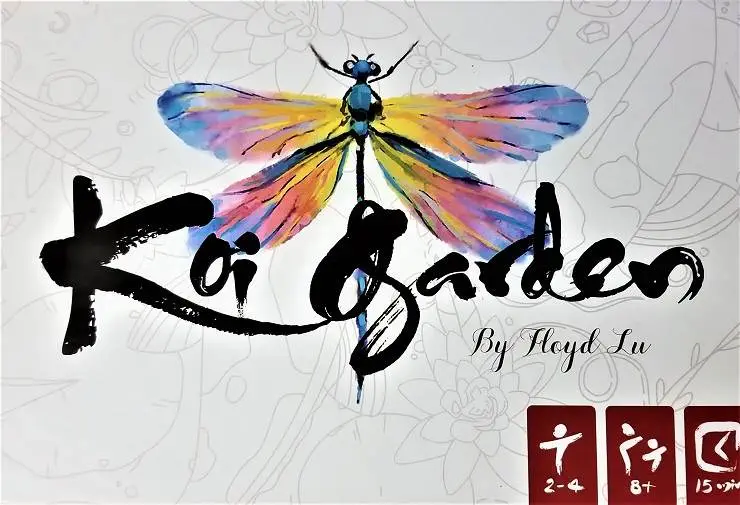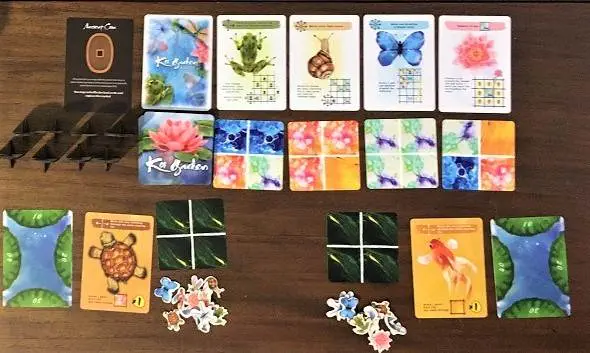
To sit back and admire the beauty of nature in one’s own back yard brings peace to the soul. The gentle sound of trickling water floats through the air as a soft breeze plays its way through the reeds. Animals crawl, swim, and fly from one spot to another and seem to regard the atmosphere contently. All this is portrayed for your enjoyment in this review’s game: Koi Garden.
Koi Garden is a 2-4 player tile-laying game self-published by designer Floyd Lu. Lu’s other designs include games such as Noises at Night and The Refuge: Terror From the Deep. The watercolor effect of the art, created by Darina Lapkovskaya, helps convey the aesthetic of the environment and atmosphere to life. The animals are drawn with individual features that bring character and charm to each of them. We should mention that this preview was done with a prototype copy of the game so elements and components may change during the Kickstarter campaign.

At the beginning of each game, players will receive a starting land card, starter wildlife card, Zen point tracker, and a full set of wildlife tokens. The starter wildlife cards have a colored background that differentiates them from the others, which helps make this part of the setup much easier. The remaining land cards should then be shuffled and placed face down in the play area. Four of the land cards are dealt face up next to the draw pile to create a “land market.” Once this is done, the remaining wildlife cards are shuffled and one wildlife card is dealt into the space above each of the four land cards to form a second row. It is important to note that each land card is made up of four spaces referred to as “tiles.” The stone lanterns are placed by the play area and a tool card is chosen at random to be used for the game and placed within the view of all players.
The number of rounds per game will depend on the number of players. On a player’s turn, they will choose a land card and add it to their pond. The card can be rotated as needed to optimize its placement. There are several restrictions to keep in mind when placing cards such as never fully covering the starting land card and how many tiles can and can not be covered on the same card. These are explained in the rules. Next, the player will take the wildlife token that matches their current wildlife card and move that creature to score points. Each creature’s movement and scoring conditions are shown on its card. Once the creature has ended its movement, points are scored. The player will swap wildlife cards with the one above the empty space and then refill the market. Once per turn, a player may choose to use the tool card. If they do, it comes at a price: earning a stone lantern. These lanterns must be placed during the turn they are received and act as impassable obstacles to the creatures. Once these steps are completed, it is then the next player’s turn, and play continues until all rounds have been played. The player with the most points wins.
Koi Garden was not what we expected. The rulebook was not well written, and the game was harder to learn because of it. Lu’s personal how-to-play video contradicted the provided rulebook (which is the same one included in Tabletop Simulator) and some rules were so confusing we chose to ignore them rather than figure them out. It is for these reasons that we cannot give an honest review of the game because we do not know what it actually plays like. The concept is there and certainly has an appeal, but we felt that some more blind playtesting should have been done before the Kickstarter. It should also be mentioned that Koi Garden will be available exclusively on Kickstarter and nowhere else unless you find a copy online or from a retailer who picked up some copies for their local stock. While this isn’t always a concern, we feel that backers of Kickstarter exclusive games should receive a game that not only doesn’t need a walkthrough experience with the designer themselves but is playable out of the box. Unfortunately, Koi Garden does not provide this based on the preview copy we received. There is also a strong lack of player interaction that is intentionally built into the game, as mentioned by the designer in an interview, as Lu chose to design the game with the feel of each player designing and working in their own garden. This exclusivity and lack of attention to detail, unfortunately, culminate into our not recommending this game to friends, family, or our readers.
All photos of Floyd Lu’s Koi Garden were taken and edited by Krista.